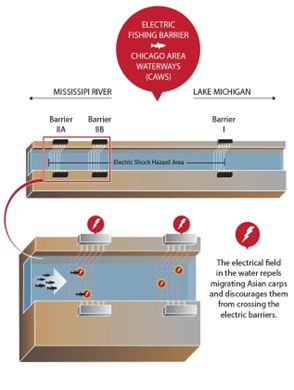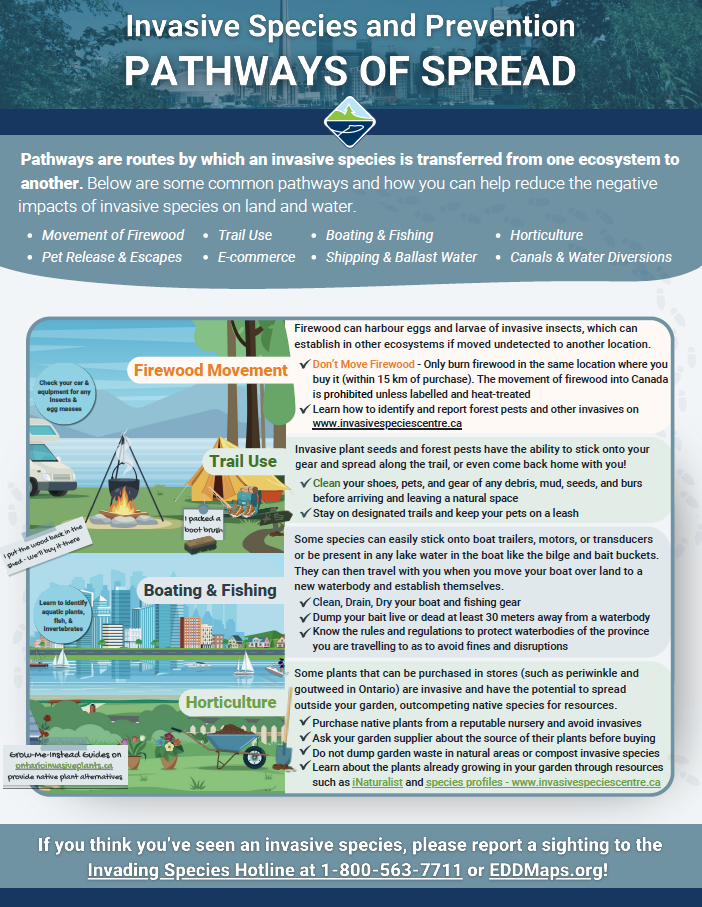Pathways of Spread for Invasive Species
Pathways are routes by which an invasive species is transferred from one ecosystem to another. Below are some common pathways of spread and how you can help reduce the negative impacts of invasive species on our land and water.
Common pathways of spread include:
Jump to:
Trail Use
You can help prevent the spread of invasive species when you’re on the trails by cleaning your shoes, pets, and gear before arriving and before leaving a natural space. Invasive plant seeds have the ability to stick onto these items and spread along the trail, or even come back home with you! Be sure to remain on designated trails to reduce the chance of dropping off or picking up any invasive species.
What can YOU do?
- Use a boot brush station or hand-held brush to brush off your footwear and gear along with picking off any debris, mud, seeds and/or burs from your clothes and pets
- Stay on designated trails and keep your pets on a leash
- Learn how to identify invasive plants and forest pests
- Report any suspected sightings to the Invading Species Hotline at 1-800-563-7711 or EDDMaps.org
Visit the Play. Clean Go website to learn more.
Boating and Fishing
Boating and fishing are two common pathways for the spread of invasive species. There are several different measures you can put in place to ensure that you are doing your best to prevent the spread while out on the water.
Clean, Drain, Dry
Some species can easily stick onto boat trailers, motors, or transducers, or be present in any lake water in the boat like bait buckets, live wells, and the bilge. These species can travel with you when you move your boat over land to a new waterbody and establish themselves. To prevent the transport of invasive species, many provinces Ontario, Manitoba, Alberta, and British Columbia have regulated watercrafts and their equipment as “carriers.” In Ontario, this pathway is regulated under the Invasive Species Act as of January 2022. Under this act, watercraft users must clean their boat of any visible aquatic vegetation or debris and drain any standing water in the boat. For additional recommendations check out Clean, Drain, Dry!
Know Before You Go
Know Before You Go is a campaign to raise awareness of your responsibilities as a recreational boat owner in knowing the rules and regulations in the province you are travelling to. Canada’s western provinces are working hard to prevent the spread of invasive mussels. Did you know that detection dogs also joined the search for invasive mussels at inspection stations in some provinces?
Learning about these rules and regulations will protect Canada’s water and help you avoid disruptions and fines ranging from $174 to $2542 depending on the jurisdiction and offence.
It’s always a good idea to inspect your watercraft and clean, drain, and dry it to help reduce the harm to Canada’s waterbodies. Make sure you review the in the jurisdiction you’re in for specific requirements.
Don’t Dump Your Bait
Anglers often enjoy using live bait while fishing, but improper disposal can lead to a new invasion. Ontario is now divided into four Bait Management Zones to help regulate and prevent the accidental release of non-native species into new bodies of water. A complete description of the baitfish rules and regulations can be found here.
What can YOU do?
- Learn to Clean, Drain and Dry your boat
- Learn to Clean, Drain and Dry your fishing gear
- Dump your bait live or dead on land at least 30 meters from a waterbody
- Learn to identify invasive aquatic plants, fish, and invertebrates
- Report any suspected sightings to the Invading Species Hotline at 1-800-563-7711 or EDDMaps.org
E-Commerce
The ability to easily buy and sell live organisms online provides a high-risk pathway for the importation of non-native organisms into Canada. Issues related to e-commerce as a pathway include inaccurate or unclear taxonomic information provided by sellers, limited consumer knowledge regarding items purchased and associated risk, challenges regarding the regulation of this pathway, and the subsequent release or escape of these organisms into Canada’s natural environment.
What can YOU do?
- Don’t let your aquatic pets loose!
- Purchase native plants for gardens, ponds, and aquariums
- Purchase aquarium species and pond species from reputable retailers
- Learn to identify invasive species
Report any suspected sightings to the Invading Species Hotline at 1-800-563-7711 or www.EDDMaps.org.
For more information on what you can do to circumvent the risk when buying organisms online, please visit the Canadian Food Inspection Agency website.
Pet Release and Accidental Escapees
For some, owning an aquarium with exotic species can be an enjoyable pastime, however, some of these species have the potential to survive in our waters and outcompete our native species for resources. This also includes ponds and water gardens.
Exotic pets also have the possibility of accidentally escaping captivity. This was seen in Florida where captive Burmese pythons accidentally escaped due to the destruction caused by Hurricane Andrew. These pythons now cause harm to Florida’s ecosystem by decimating native species.
To avoid accidental release of species from ponds or water gardens, they should be placed away from natural waterways or areas that might experience flooding. For aquarium owners, choose a reputable retailer to purchase your pets from. Never dispose aquatic/exotic pets or plants into natural waterways.
Don’t let it loose! To learn more visit our page.
Goldfish, when released into the wild, are an invasive species in North America. Goldfish can lower the clarity of water due to their feeding habits and have a high reproductive rate. Together, these make goldfish a threat to Canadian waters.
What can YOU do?
- Don’t let your aquatic pets loose!
- Purchase native plants for ponds
- Purchase aquarium species from a reputable retailer
- Learn to identify invasive aquatic plants, fish, and invertebrates
- Report any suspected sightings to the Invading Species Hotline at 1-800-563-7711 or EDDMaps.org
Firewood
The movement of firewood plays a significant role in the accidental spread of invasive insects, as firewood and its bark can harbor eggs and larvae of invasive insects. If moved undetected, these eggs and larvae are then transported to another location where they can establish and begin to impact local ecosystems. It is extremely important that you do not transport these invasive insects outside of their regulated area.
Don’t Move Firewood
Burning firewood in the same location where it was purchased is one of the surest ways to avoid spreading any invasive insects. The rule of thumb is to avoid travelling more than 15km outside of the area where you are planning to burn the firewood. Make it a customary practice to pick up firewood after you have reached your destination. The movement of firewood into Canada is prohibited unless labeled and heat-treated.
Buy the Proper Wood
If the opportunity is available, choose to buy certified heat-treated (kiln-dried) firewood. This wood has been treated and avoids the risk of spreading invasive species.
Inform Yourself
It is important that you educate yourself and keep up to date on the laws of transporting firewood in your area and the rules of the campground/area. Below are some helpful resources:
CFIA – Regulated Pests (Distribution Maps)
What can YOU do?
- Don’t move firewood, purchase it within 15km of where you will be burning it
- Check your car and equipment for insects and egg masses
- Learn to identify invasive forest pests
- Familiarize yourself with legislation related to Regulated Zones and firewood movement
- Report any suspected sightings to the Invading Species Hotline at 1-800-563-7711 or EDDMaps.org
Horticulture
Gardening can be a great hobby and way to spend time outdoors, but it is important to educate yourself on what you are planting. Some plant species are invasive and have the potential to spread outside of your garden, outcompeting native species for resources. Some invasive species can be purchased in stores, including common garden plants such as periwinkle and goutweed.
You can help prevent the spread of invasive species from your garden by planting native species instead. The Ontario Invasive Plant Council has created practical and easy-to-use guides for populating your garden with beautiful native/non-invasive alternatives to commonly used invasive plants available for both Southern and Northern Ontario.
In addition to using these guides, what can YOU do?
- Purchase your plants from a reputable nursery
- Ask your garden supplier about the source of their plants before purchasing and encourage them to provide native species
- Learn about the plants already growing in your garden through resources such as iNaturalist and our species profiles.
- Dispose of invasive garden waste in black construction grade garbage bags and leave it on a hard surface in the sun for a minimum of one week before disposing. Do not dump garden waste in natural areas or compost invasive species.
- Learn to identify invasive plants
- Report any suspected sightings to the Invading Species Hotline at 1-800-563-7711 or EDDMaps.org
Shipping and Ballast Water:
Ballast water is drawn in at the ship’s origin and must be pumped out at its destination prior to unloading the ship’s cargo. Many organisms can survive within this water as the ship crosses into new areas, including species like Zebra mussels.
The Great Lakes are a major pathway for ocean freighters to ship cargo to and from Canada to overseas. This has resulted in over 180 non-indigenous aquatic species to establish within the Great Lakes Basin. As of 2006, the federal governments of Canada and the U.S. created joint legislation requiring oceanic freighters to treat their ballast water prior to entering the Great Lakes, which have contributed to zero species being introduced since.
You can view regulations and legislation regarding ballast water here.
Canals and Water Diversions
Canals and water diversions are a great way to make navigation and shipping by boat easier for larger vessels. With the ease of boats moving from one body of water to the next, making these connections has also allowed for invasive species to easily move between bodies of water. This was proved successful for species like Sea Lamprey.
Other species are an increasing threat to the Great Lakes due to canals and water diversions. This includes Asian carps. The Chicago Sanitary and Ship Canal within the Chicago Area Waterways is the only navigational access point for ships between Lake Michigan and the Mississippi River. There are currently no established populations of Asian carps in the Canadian waters of the Great Lakes, however, there are in the Mississippi River. There are currently efforts in the Chicago Sanitary and Ship Canal to keep these fish from crossing into the Great Lakes using electric dispersal barriers. You can learn more about these efforts here.

Download a printable PDF about invasive species pathways of spread here.

